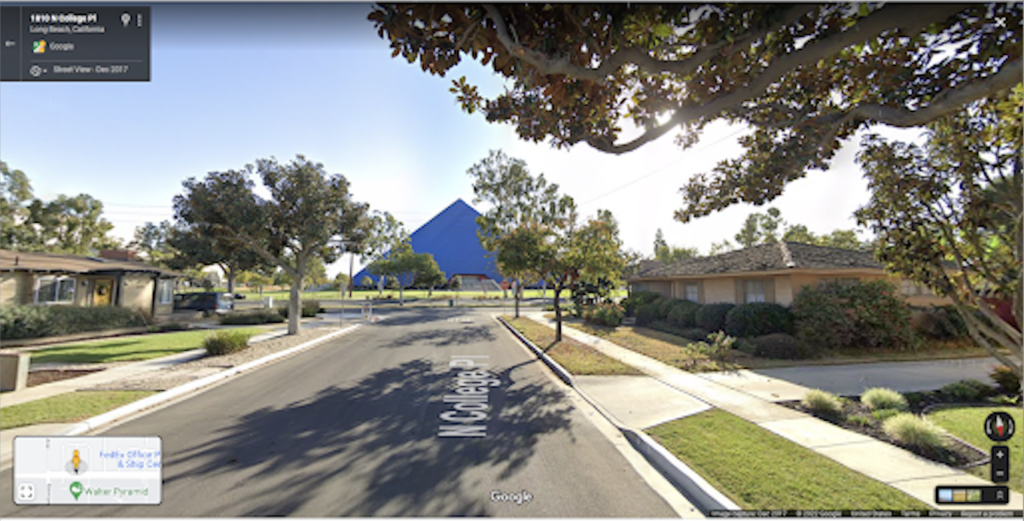We all come to housing advocacy from different places, literally and figuratively. As I take on the role of Director of Policy and Research for Abundant Housing LA, I wanted to take some time to introduce myself, in the context of the neighborhoods where I have lived.
Neighborhoods help to shape us in powerful and often subtle ways. They can influence our ideas about what is “right” and “normal” in a community. Having been fortunate to have lived in five distinct neighborhoods, I can attest that they all offer lessons about housing policy.
Starting with this post, I write about my experience with each neighborhood, and how they informed my views on housing. I am going to start with the neighborhood of my childhood, Los Altos, Long Beach.
Like what you are reading? Sign up to receive more content like this
Los Altos, Long Beach, CA

Los Altos suburbia and the Pyramid, near where I grew up. Source: Google Maps
I grew up in a house on the far east side of Long Beach, near Cal State Long Beach and the 405/605 Freeway Interchange. The neighborhood is classic 1950s suburbia: single-family zoning, strip malls at the intersections of some arterial streets.
Sound familiar? It should. According to the American Community Survey (ACS), about 20% of the housing in Los Angeles County was built in the 1950s, an era of explosive suburban growth that marks the dawn of the huge Baby Boom generation after World War II. My parents were able to buy a house there in the 1970s on public school teachers’ salaries.
Growing up, I didn’t ride transit much, and I got a driver’s license as soon as I could, like pretty much everyone else my age I knew. I didn’t think about housing affordability much. My parents had steady jobs, we had a roof over our head, we never moved. For me, that was just normal. It didn’t occur to me until later that many other people are not as privileged as I am.
Young families today, including my own family, would have a much harder time affording to live in the neighborhood where I grew up: Data from the LA County Assessor shows recent home sales in the immediate area have run from the high $700,000s to the low $900,000s.
Despite high market prices, the assessed value of my parents’ home is under $200,000. This is thanks to 1978’s Proposition 13, which limits the rate of increase in property taxes. I love my parents and I’m not trying to pick on them here, but I do want to illustrate the larger point, which is that existing property owners don’t necessarily feel the housing affordability crisis. They often have fixed-rate mortgages and pay property taxes that are based on the legal fiction that their homes are worth much less than the market value.
Like what you are reading? Sign up to stay connected
It strikes me in retrospect how segregated my old neighborhood is. Of course, and thankfully, racial covenants and redlining are no longer legal practices. But the legacy of those practices endures: 2019 data shows that only 39% of households were headed by someone who identified as “non-Hispanic white” (using Census terminology) in the city of Long Beach, but in the census tract where I grew up, that figure is about 69%.
That toxic brew of racist housing policy would have barred my father, a Black man, from living in his neighborhood, had he tried to do so prior to Shelly v. Kraemer in 1948, or the passage of the Fair Housing Act in 1968. Other racist laws prevalent in America could have barred him from marrying my mother, a white woman, until Loving v. Virginia shut that down in 1967. While my father made it into a neighborhood racist policy tried to exclude him from, many more people of color and people with low incomes weren’t as fortunate.
Another lesson from this neighborhood is that state-owned land is a good opportunity to get around restrictive local zoning. Look no further than the big blue Walter Pyramid on the campus of Cal State Long Beach. It symbolizes what is possible when we dare to let our cities be architecturally interesting.
Los Altos remained my home until I moved out for college. I will be back for more musings about where I have lived and what I have learned from these places. Stay tuned!
Like what you just read? Sign up to receive updates on housing



